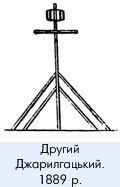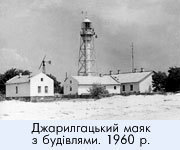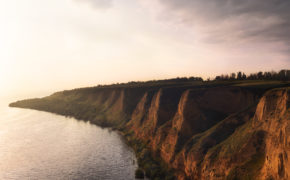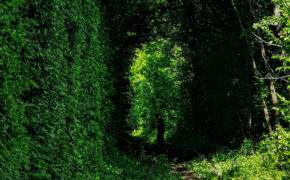Dzharylgach lighthouse
Type: Industrial object Kind: Historical (Inactive)
Country: Ukraine Region: Kherson region Locality: Джарилгач
Availability: State, Not available for visits, Emergency condition
Unlike many of the objects that we visited, there is a lot of information about the Dzharylgach lighthouse. Although much of it is purely chronological (who, in what years, was a caretaker, technical data), the history of this building can be traced quite easily.
Before the lighthouse itself appeared, lighthous signs helped the sailors.
The first Dzharylgach lighthouse sign was installed in 1826. And it was located on the southern coast of the low Dzharylgach spit, almost on the half of its length, opposite the village of Krasnoe. The second Dzharylgach sign was also established in 1826 on the lowland tip of the Dzharylgach spit.
The 1851 map of the Tendrovsky Spit shows “1 Zn”, “2 Zn”, and “3 Zn”, going from west to east, the “4 Zn” mark is clearly visible, on the Dzharylgach spit opposite the village of Krasnoye, and “5 Zn” – on the eastern end of the Dzharylgach. In the “Sailing directions of the Black Sea”, 1851, it is said that “entering the bay in the spring remains only on peering into the lighthouse signs.”
In 1889, the “5 Zn” or “Second Dzharylgachsky” sign was restored. The new sign consisted of a mast with props and a horizontal barrel on the mountain, and a horizontal rail was located under the barrel. The sign was to serve to identify the low coast of the Dzharylgach spit. After the founding of the port of Skadovsk, the ships going to the Dzharylgach bay, the harbors of Khorly and Churyum, could take the pilot who lived in Skadovsk at this sign. The sign was subordinated to the director of lighthouses and sailing directions of the Black and Azov Seas.
V. Rumel, recalling 1894, indicates that in the Dzharilgach Bay, at a distance of 2 versts from the shore, the depth was up to 24 feet and the soil was suitable for anchoring. To facilitate the entry of the ships, pilot marks and floating milestones were installed. Sergei Baltazarovich Skadovsky was allowed, by Directorate of Sailing Directions, to install and maintain reference lights that indicated the direction of passage from the limb of the spit to the anchorage in front of Skadovsk.
The “Yug” newspaper dated October 10, 1899 reads: “In September 1899, the chief commander of the fleet and ports of the Black and Azov Seas, Vice Admiral Sergei Petrovich Tyrtov visited all the marinas of the Karkinitsky Bay and came to the conclusion that the Dzharylgach Bay and the port of Skadovsk are suitable for short-sea ships. The Maritime Ministry has decided to build a lighthouse on Dzharylgach island. ”
In the same 1899, Sergey Baltazarovich Skadovsky bought the island of Dzharylgach from landowner Vassal Alexander Romanovich, and in the spring of 1900, the Ministry of the Sea began construction of the lighthouse, in the very place where the 5 Zn lighthouse has been operating for almost 75 years.
The height of this lighthouse is 24.4 meters. Its central part in the form of a cylinder provided sailors with visibility of light up to 14.8 miles. The light was of two colors – white and red. There was a telephone on the lighthouse to receive telegrams.
All his technical equipment and a metal frame were made in Paris with the money of S.B. Skadovsky. There is information that the openwork metal frame of the lighthouse and its necessary devices were designed by the French architect A. G. Eiffel. According to other sources, the lighthouse was designed by one of his students.
The light-optical apparatus of the lighthouse consisted of one kerosene-fire burner (instead of fifteen oil ones on old systems) and gave a beam of light with a power of 150,000 candles instead of several hundred in old ones. The burner light was focused in a Fresnel lens with a diameter of up to 1.5 meters, which consisted of a pair of rows of glass hoops intertwined in a bronze frame. This lens of the Dzharylgach lighthouse has been preserved to this day. It was put on a new lighthouse, and LED lamps, powered from solar panels providing light.
The light-optical apparatus of the Dzharylgach lighthouse was made by the French company “Barbier et Benard”, which was founded in 1862 by Frederic Barbier and Stanislas Fenestra. At the beginning of the twentieth century it received the current name “Barbier, Benard et Turenne” (BBT). At the turn of the XIX-XX centuries, the company became the world leader in the construction of lighthouses.
In 1958, a 500-watt electric lamp was installed on the lighthouse, which provided light visibility for 23 miles. The battery was powered by a diesel generator.
In Skadovsk, you can hear the story of the bell that was on the lighthouse. They say there is an act of transferring it from the lighthouse service of the Dzharylgach lighthouse to Sevastopol. There is a version that this is not a usual bell, and that earlier it was on one of the towers of Notre Dame de Paris, and then, during the war of 1812, it was transferred to the Russian Empire, so it ended up on a lighthouse on Dzharylgach. And there seem to be photos of this bell. During fog, a lighthouse worker had to beat the bell for a certain time so that ships that did not see the light would hear at least a sound and not run aground. But where are all these documents – all these stories are silent ..
Dzharylgach lighthouse with a complex of residential buildings was built 200 meters from the sea. In the 20s of the twentieth century. a border detachment was stationed in them, later the lighthouse maintenance staff lived there, there was a weather station. In the 60s. a storm destroyed one of the buildings. Later, they had to disassemble others. Currently, these buildings are no longer there, they were destroyed by the sea (leaving one corner of sawn limestone). Every year it stepped on a meter – meter and a half. At the moment, the lighthouse stands almost at the water’s edge, and not two hundred meters from the seashore. In the photo from the drone it is seen that the destroyed buildings are going under water. It is doubtful that they were built on the coastline (although who knows, but really doubtful). This means that there is a chance that the island has decreased by at least 50 meters in a hundred and a few years, or even by all 200 meters (and this is from the one side).
105 steps led to the observation deck of the lighthouse, from there you could see the whole island, the mainland coast and even Crimea. In September 2005, the lighthouse stopped functioning and the entrance was closed.
This cultural monument is constantly exposed to erosion from the sea. There are several options for what to do with it. Some officials want to move it to Skadovsk, restore it and leave it as a landmark, others want to move it further inland and restore it, but the first ones don’t want to allocate funds for this, there is a third opinion – leave everything as it is and give the lighthouse to the sea, but the above stated two camps don’t what to do that. In addition, there are intentions to dismantle the old Dzharylgach lighthouse, since there is no one to look after him. At the moment, the lighthouse is being taken up by nature, while everyone together decides whose it will be and what to do with it.
In 1997, a new 24-meter lighthouse was built 50 meters from the Dzharylgach lighthouse.
Based on materials: source 1, source 2, source 3.








